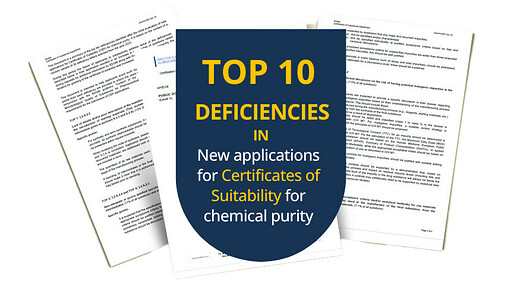The document summarizes the top ten deficiencies identified after evaluating new applications for Certificates of Suitability (CEP) for chemical purity. The content is intended to help applicants build their applications in conjunction with the EDQM guideline “Content of the Dossier for Chemical Purity and Microbiological Quality of Substances for Pharmaceutical Use.” The deficiencies are listed, and details on how to avoid them are provided for users to help improve the quality of their applications.
TOP 3: 3.2.S.3.2 Absence or deficient discussion on the risk of having potential mutagenic impurities in the final substance. (7.5% of all questions)
Specific points:
CEP applicants are expected to provide a specific discussion in their dossier regarding potential mutagenic impurities based on their understanding of the manufacturing process for the substance. This should include those: a) introduced during the manufacturing process (e.g., reagents, starting materials, etc.) b) arising from the synthesis of the final substance c) formed as a result of degradation. Such impurities should be listed and classified (class 1 to class 5) in the dossier in accordance with ICH M7. For mutagenic impurities, a suitable control strategy in accordance with the principles of ICH M7 should be proposed. The Threshold of Toxicological Concern (TTC) for an impurity should be determined in accordance with ICH M7. For the calculation of the TTC, the Maximum Daily Dose (MDD) of the drug substance should be based on the Human Medicine European Public Assessment Report (EPAR), Summary of Product Characteristics (SmPCs), or agreed literature such as Martindale, while the appropriate acceptable intake should be based on an appropriate duration of use as described in ICH M7. ICH M7 option 3 controls for mutagenic impurities should be justified with suitable spiking and/or carryover studies. ICH M7 option 4 controls should be supported by a demonstration that, based on understanding of the process and impact on residual impurity levels (including fate and purge knowledge), the level of the impurity in the drug substance will always be below the acceptable limit. Option 4 controls may additionally need to be supported by analytical data (e.g., spiking and/or carryover studies).
TOP 7: 3.2.S.3.2 Absent or deficient risk assessment related to Nitrosamines. (4% of all questions)
Specific points:
New CEP applications (chemical, semi-synthetic, products of fermentation, or herbals) are expected to include a comprehensive risk assessment for the presence of nitrosamines based on the principles outlined in the ICH Q9 and ICH M7 guidelines, as well as the current EMA Q&A document on nitrosamines (incl. its Appendix 1). The risk assessment should address not only risks from the manufacturing process but also those from the introduction of materials used in the manufacturing process (starting materials, reagents, solvents – fresh and recovered, etc.) as well as degradation. Any risk concerning the formation and carryover of nitrosamines should be suitably addressed, taking into account the above-mentioned EMA Q&A document.
